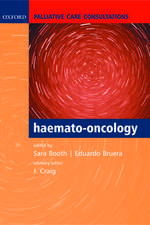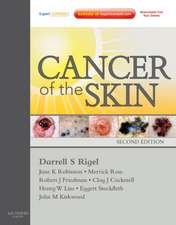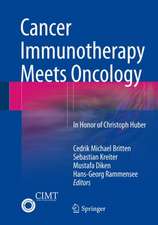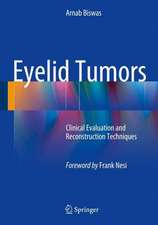Skin Cancer after Organ Transplantation: Cancer Treatment and Research, cartea 146
Editat de Eggert Stockfleth, Claas Ulrichen Limba Engleză Hardback – 8 mai 2009
The increasing incidence of non-melanoma skin cancer, paralleling a prolonged survival of patients after organ transplantation, represents a significant reason for morbidity and long-term morbidity in organ transplant recipients worldwide. The incidence of non-melanoma skin cancer in liver-, kidney- and heart transplant recipients varies from 1.5 to 22 %, 2 to 24 % and 6 to 34 % after < 5 years post transplant. Ultraviolet radiation as well as immunosuppressive therapy are crucial risk-factors regarding the induction and progression of skin cancer. Ultraviolet radiation is related to the induction of DNA damage, as well as interference with Langerhans cell antigen presentation and a Th1 – Th2 shift induced via a release of IL-10. Whereas the overall duration of immunosuppression and the cumulative dosage applied are relevant parameters in the evaluation of an increased tumor risk, individual differences between specific immunosuppressive agents remain unclear. The workup of genetic as well as other unclear phenomenon like the reverse BCC/SCC ratio might shed some further light into the genesis and immunology of the non-melanoma skin cancer in general.
| Toate formatele și edițiile | Preț | Express |
|---|---|---|
| Paperback (1) | 1407.79 lei 38-44 zile | |
| Springer Us – 8 dec 2010 | 1407.79 lei 38-44 zile | |
| Hardback (1) | 1433.10 lei 6-8 săpt. | |
| Springer Us – 8 mai 2009 | 1433.10 lei 6-8 săpt. |
Din seria Cancer Treatment and Research
- 5%
 Preț: 1103.03 lei
Preț: 1103.03 lei - 5%
 Preț: 726.32 lei
Preț: 726.32 lei - 5%
 Preț: 787.58 lei
Preț: 787.58 lei - 5%
 Preț: 1037.93 lei
Preț: 1037.93 lei - 5%
 Preț: 1032.64 lei
Preț: 1032.64 lei - 5%
 Preț: 1041.77 lei
Preț: 1041.77 lei - 5%
 Preț: 917.42 lei
Preț: 917.42 lei - 5%
 Preț: 719.02 lei
Preț: 719.02 lei - 5%
 Preț: 920.18 lei
Preț: 920.18 lei - 5%
 Preț: 1040.88 lei
Preț: 1040.88 lei - 5%
 Preț: 1044.58 lei
Preț: 1044.58 lei - 5%
 Preț: 721.19 lei
Preț: 721.19 lei - 5%
 Preț: 370.38 lei
Preț: 370.38 lei - 15%
 Preț: 700.10 lei
Preț: 700.10 lei - 5%
 Preț: 2116.84 lei
Preț: 2116.84 lei - 5%
 Preț: 1414.08 lei
Preț: 1414.08 lei - 5%
 Preț: 1424.16 lei
Preț: 1424.16 lei - 5%
 Preț: 1106.69 lei
Preț: 1106.69 lei - 5%
 Preț: 1297.62 lei
Preț: 1297.62 lei - 5%
 Preț: 1103.22 lei
Preț: 1103.22 lei - 5%
 Preț: 1094.44 lei
Preț: 1094.44 lei - 5%
 Preț: 1096.45 lei
Preț: 1096.45 lei - 5%
 Preț: 1413.56 lei
Preț: 1413.56 lei - 5%
 Preț: 720.10 lei
Preț: 720.10 lei - 5%
 Preț: 706.77 lei
Preț: 706.77 lei - 5%
 Preț: 731.07 lei
Preț: 731.07 lei - 5%
 Preț: 1414.80 lei
Preț: 1414.80 lei - 5%
 Preț: 1108.72 lei
Preț: 1108.72 lei - 5%
 Preț: 1098.12 lei
Preț: 1098.12 lei - 5%
 Preț: 1092.22 lei
Preț: 1092.22 lei - 5%
 Preț: 1099.56 lei
Preț: 1099.56 lei - 5%
 Preț: 1106.33 lei
Preț: 1106.33 lei
Preț: 1433.10 lei
Preț vechi: 1508.52 lei
-5% Nou
Puncte Express: 2150
Preț estimativ în valută:
274.25€ • 297.80$ • 230.38£
274.25€ • 297.80$ • 230.38£
Carte tipărită la comandă
Livrare economică 23 aprilie-07 mai
Preluare comenzi: 021 569.72.76
Specificații
ISBN-13: 9780387785738
ISBN-10: 0387785736
Pagini: 497
Ilustrații: XVII, 497 p.
Dimensiuni: 155 x 235 x 25 mm
Greutate: 1 kg
Ediția:2009
Editura: Springer Us
Colecția Springer
Seria Cancer Treatment and Research
Locul publicării:New York, NY, United States
ISBN-10: 0387785736
Pagini: 497
Ilustrații: XVII, 497 p.
Dimensiuni: 155 x 235 x 25 mm
Greutate: 1 kg
Ediția:2009
Editura: Springer Us
Colecția Springer
Seria Cancer Treatment and Research
Locul publicării:New York, NY, United States
Public țintă
ResearchCuprins
– Historical Perspective.- – Historical Perspective.- Skin Cancer After Transplantation: Where Did We Come From, Where Do We Go?.- Transplant Medicine.- De Novo Post-Transplantation Malignancies: Incidence and Risk Factors.- Immunosuppression.- Skin Immune System.- Post-Transplant Cancer.- Post-Transplant Skin Cancer: The Influence of Organ and Pre-Transplant Disease.- The Epidemiology of Transplant-Associated Keratinocyte Cancers in Different Geographical Regions.- Etiological Factors in Cutaneous Carcinogenesis – An Introduction.- Photocarcinogenesis – DNA Damage and Gene Mutations.- Ultraviolet-Induced Immunosuppression: Implications for Photocarcinogenesis.- Carcinogenic Mechanisms Related to Immunosuppressive Therapy.- Oncogenic Viruses.- Epidemiology of Cutaneous Human Papillomavirus Infections.- Interaction Between Ultraviolet Radiation and Human Papillomavirus.- Human Herpesvirus 8.- Molecular Events in Skin Cancer.- Molecular Pathogenesis of Basal Cell Carcinoma.- Molecular Pathogenesis of Squamous Cell Carcinoma.- New Trends in the Susceptibility to Melanoma.- Specific Skin Cancers.- Actinic Keratoses.- Squamous Cell Carcinoma.- Basal Cell Carcinoma.- External Anogenital Premalignant and Malignant Disease.- Kaposi’s Sarcoma.- Malignant Melanoma.- Rare Skin Cancers.- Merkel Cell Carcinoma.- Cutaneous Lymphomas.- Appendageal Malignancies.- Prophylaxis and Therapy.- The Role of the Transplant Physician in the Management of Skin Cancers After Organ Transplantation.- Pretransplantation Dermatologic Screening and Prophylaxis.- Aftercare – A Multi-disciplinary Approach.- Evaluation of Patient Education.- Sunscreens and Sun Protection.- Surgical Intervention for Skin Cancer in Organ Transplant Recipients.- Topical Treatment of Field Cancerization.-Destructive Management of Skin Cancers in Organ Transplant Recipients.- Systemic Chemoprevention.- Management of Metastatic Skin Cancers in Organ Transplant Recipients.
Textul de pe ultima copertă
Skin Cancer after Organ Transplantation presents the state-of-the-art knowledge of cutaneous malignancies following organ transplantation. The life promoting and life enhancing benefits of solid organ transplantation is a major medical advance, but at the cost of the life-long immunosuppression needed to prevent rejection of the donated organ. This induction and maintenance of impaired immunological surveillance is paralleled by a significant increase in the incidence of specific cancers, of which skin cancers are highest.
The book is divided into four sections, providing a basic overview on transplantation medicine, different immunosuppressive agents and their impact on the skin’s immune system, epidemiology and pathophysiology of skin cancer, applicable prophylaxis and therapeutic measures.
1. Transplant medicine: Addresses the immunological background of organ transplantation, immunosuppression and the impact on the cutaneous immunosurveillance. Different immunosuppressive drugs are presented and their interaction with mechanisms of the cutaneous immunosurveillance against skin cancer, are discussed.
2. Post-transplant skin malignancies: Explores the pathogenesis of transplant skin cancer, epidemiological patterns in different geographical regions, clinical and histological features, etiological factors and molecular events in skin cancer induction and progression, i.e., photocarcinogenesis and UV-induced immunosuppression, and oncogenic viruses like human papillomavirus and human herpesvirus, type 8.
3. Specific skin cancers: Focuses on specific skin cancers in organ transplant recipients, especially the most predominant types, like squamous cell carcinoma, its precursor actinic keratoses, and basal cell carcinoma, but also malignant melanoma, Kaposi’s sarcoma, cutaneous T-cell lymphoma and other, more rare skinmalignancies.
4. Prophylaxis and therapies: Experts in the field recommend management strategies for preventing and treating transplant skin cancer, with an emphasis on a multidisciplinary approach. As scientists and clinicians strive together to develop effective chemopreventative agents in the face of this accelerated carcinogenesis, there is a real opportunity for advances in the treatment of transplant skin malignancies to translate into reduced skin cancer in the general population.
"Immunosuppression is an essential component of organ transplantation. Unfortunately, the risk of skin cancer is drastically increased in this setting. Distinguished investigators discuss the cause and therapeutic strategies involving the spectrum of cutaneous malignancies associated with immunosuppression." Steven T. Rosen, M.D., Series Editor
The book is divided into four sections, providing a basic overview on transplantation medicine, different immunosuppressive agents and their impact on the skin’s immune system, epidemiology and pathophysiology of skin cancer, applicable prophylaxis and therapeutic measures.
1. Transplant medicine: Addresses the immunological background of organ transplantation, immunosuppression and the impact on the cutaneous immunosurveillance. Different immunosuppressive drugs are presented and their interaction with mechanisms of the cutaneous immunosurveillance against skin cancer, are discussed.
2. Post-transplant skin malignancies: Explores the pathogenesis of transplant skin cancer, epidemiological patterns in different geographical regions, clinical and histological features, etiological factors and molecular events in skin cancer induction and progression, i.e., photocarcinogenesis and UV-induced immunosuppression, and oncogenic viruses like human papillomavirus and human herpesvirus, type 8.
3. Specific skin cancers: Focuses on specific skin cancers in organ transplant recipients, especially the most predominant types, like squamous cell carcinoma, its precursor actinic keratoses, and basal cell carcinoma, but also malignant melanoma, Kaposi’s sarcoma, cutaneous T-cell lymphoma and other, more rare skinmalignancies.
4. Prophylaxis and therapies: Experts in the field recommend management strategies for preventing and treating transplant skin cancer, with an emphasis on a multidisciplinary approach. As scientists and clinicians strive together to develop effective chemopreventative agents in the face of this accelerated carcinogenesis, there is a real opportunity for advances in the treatment of transplant skin malignancies to translate into reduced skin cancer in the general population.
"Immunosuppression is an essential component of organ transplantation. Unfortunately, the risk of skin cancer is drastically increased in this setting. Distinguished investigators discuss the cause and therapeutic strategies involving the spectrum of cutaneous malignancies associated with immunosuppression." Steven T. Rosen, M.D., Series Editor
Caracteristici
There is an emerging need for a high-grade scientific and clinical book related to chronic immunosuppression in transplant patients (more than 1,000,000 world wide) Provides an answer on the dramatically increased skin cancer incidence in this group of patients Comprehensive overview on scientific background, introduction into transplant medicine, posttransplant malignancies and risk-factors related with evidence-based therapeutic advice Interdisciplinary access for interdisciplinary management of high risk patients Tables and clinical pictures (color) will enable broad range of non-dermatologic physicians to use the book for first diagnosis in daily practice













